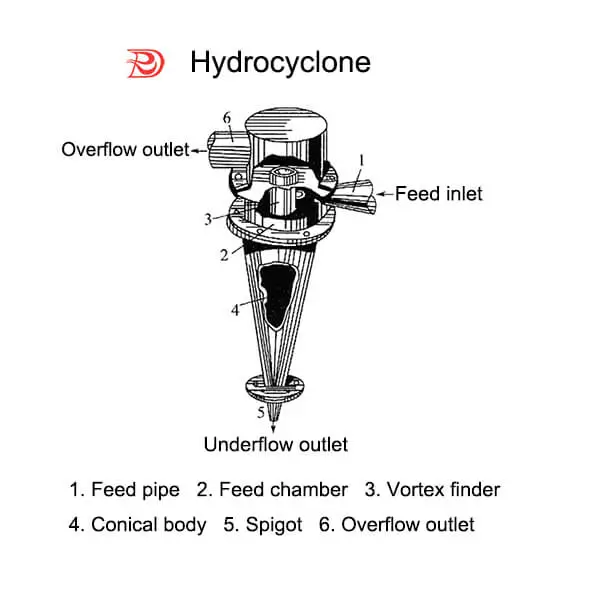ما هو الهيدروسيكلون مع بطانة مطاطية مقاومة للاهتراء؟
Hydrocyclone هو جهاز يفصل الملاط باستخدام قوة الطرد المركزي. في أيامه الأولى، لم يتم اعتماده على نطاق واسع بسبب التآكل السريع وعمر المعدات القصير والتحكم الصعب في معلمات العملية. ومع ذلك، مع إدخال بطانات مطاطية مقاومة للتآكل في Hydrocyclones، زاد عمرها بشكل كبير، واكتسب قبولًا واستخدامًا واسع النطاق في السوق.
في هذه المقالة، سنقدم نظرة عامة مفصلة على الأعاصير المائية المقاومة للتآكل، بما في ذلك بنيتها ومبادئ عملها ووظائفها المحددة وتطبيقاتها والمشكلات الشائعة والاعتبارات.
أولا: بنية ومبادئ عمل الأعاصير المائية:

كما هو موضح في الرسم التخطيطي، يتكون الهيدروسيكلون من جزء علوي أسطواني مجوف وجزء سفلي مخروطي، يشكلان الغرفة. يتميز الجزء العلوي بجهاز تغذية، ويحتوي الجزء العلوي على جهاز فيض، ويتضمن الجزء السفلي مخرج رمل. يتم توصيل هذه المكونات باستخدام الشفاه والبراغي. أنبوب المدخل ومخرج الرمل والجزء الداخلي من الغرفة معرض للتآكل. لمعالجة هذا، تتم إضافة بطانات مطاطية مقاومة للتآكل، مصنوعة عادةً من المطاط، إلى هذه المناطق المعرضة للخطر.
يعتمد مبدأ عمل الهيدروسيكلون على الضغط على الملاط (بمقدار 0.5-2.5 كجم/سم²) وإدخاله إلى الحجرة بسرعة تقارب 5-12 مترًا/ثانية. وعندما يدخل الملاط، الذي يحتوي على جزيئات صلبة معلقة، الحجرة بشكل عرضي، فإن الدوران السريع للملاط يجبره على اتباع البنية الدائرية للحجرات. ويولد هذا الدوران قوة طرد مركزي، مما يجعل الجسيمات ذات الأحجام الأكبر تتغلب على مقاومة الماء بشكل أفضل بسبب جمودها الأكبر. وبالتالي، أثناء الدوران المستمر، تشكل الجسيمات ذات الأحجام المختلفة والماء طبقات بسبب قوى الطرد المركزي والجاذبية المتغيرة، مما يؤدي إلى فصل مكونات الملاط.
II. وظائف وتطبيقات الهيدروسيكلونات:
- عمليات فصل الجسيمات:
• تصنيف الجسيمات: يفصل الجسيمات ذات الكثافة المتشابهة بناءً على الحجم، ويقسمها إلى جسيمات خشنة ودقيقة أو يزيل أي فئة من المنتج. غالبًا ما يتم استخدام عدة دوامات مائية لتحسين الدقة.
• فرز الجسيمات: يقوم بفصل الجسيمات على أساس كثافتها، وذلك باستخدام الأعاصير المائية المتوسطة الثقيلة أو المتوسطة المائية.
على سبيل المثال، يستخدم مصنع يحتوي على خليط يحتوي على 160-200 جم/لتر من المحتوى الصلب، حيث تشكل الجسيمات +100 شبكة 53% والجسيمات -200 شبكة 37.4%، هيدروسيكلونات. بعد المعالجة، يحتوي منتج الفائض على 96% -100 جسيم شبكة، بينما يحتوي المنتج السفلي على أكثر من 85% +100 جسيم شبكة. - عمليات التركيز:
تعمل أجهزة الهيدروسايكلون على تركيز المواد عن طريق إزالة الماء، مما يتيح التركيز المسبق وتقليل الحمل على المعدات اللاحقة. ويمكن تحقيق معدلات تركيز تزيد عن 50% في التدفق السفلي وأكثر من 70% في إنتاجية الإنتاج. تعمل أجهزة الهيدروسايكلون غالبًا بالاشتراك مع مرشحات الفراغ وآلات الفرز وآلات إزالة الماء والمكثفات، لتحل محل أجهزة الترسيب بالجاذبية الكبيرة والمكلفة.
على سبيل المثال، في معالجة المخلفات في المنجم، يركز نظام يتألف من دوامات مائية ومكثفات وشاشات تجفيف الملاط إلى محتوى مائي أقل من 15%. - عمليات التوضيح:
تعمل أجهزة الهيدروسيكلون على إزالة المواد الطورية المشتتة من السوائل، مما يضمن نظافة السوائل. يعد الضبط المناسب للمعلمات الهيكلية، مثل القطر وزاوية المخروط، وفقًا لحجم مادة الطور المشتتة واختلاف الكثافة، أمرًا حيويًا للتوضيح الفعال. يمكن أن يؤدي الترشيح قبل جهاز الهيدروسيكلون إلى تقليل الانسداد.
في مصنع كيميائي يقوم بترشيح الملاط باستخدام كربونات الكالسيوم وجزيئات الغبار، تعمل الأعاصير المائية على إزالة الجزيئات التي يقل حجمها عن 15 ميكرومتر بكفاءة، مما يحقق معدل فصل يتراوح بين 70%-85%.
تتنوع الأعاصير المائية بشكل متزايد من حيث البنية والتطبيق. ويمكن استخدامها على التوالي لفصل المنتجات بشكل أدق، أو بالتوازي لزيادة العائد، أو في مجموعات لتحسين عمليات تجفيف المياه التقليدية. وتوجد تطبيقات لها في التعدين وصناعة الورق والبناء والكيمياء وغيرها من المجالات.
ثالثا: العوامل المؤثرة على كفاءة الهيدروسايكلون:
- القطر: تتمتع الأعاصير المائية الأكبر عادةً بكفاءة أعلى.
- زاوية المخروط: تؤدي زاوية المخروط الأكبر إلى زيادة مقاومة التدفق، مما يؤدي إلى انخفاض الكفاءة.
- قطر أنبوب المدخل: تعمل أنابيب المدخل الأكبر على تعزيز الكفاءة.
- قطر أنبوب الفائض: بفضل الضغط الثابت للغرفة، تعمل أنابيب الفائض الأكبر على زيادة الكفاءة.
- شكل وحجم المدخل: يؤثر شكل وحجم المدخل على كفاءة الهيدروسايكلون.
- قطر مخرج التدفق السفلي: تنتج المنافذ الأكبر تصنيفًا أدق؛ كما تعمل أيضًا على تحسين الكفاءة.
- خشونة الجدار الداخلي: على الرغم من أن خشونة الجدار الداخلي تؤثر بشكل طفيف على الكفاءة، فإن استخدام بطانات المطاط المقاومة للتآكل من DEF Rubber يعزز الكفاءة.
- اللزوجة الملاطية: تؤثر لزوجة الملاط المدخل على كفاءة الهيدروسيكلون.
- نسبة قطر مخرج التدفق السفلي إلى قطر مخرج التدفق الزائد (نسبة المخروط): تؤدي نسب المخروط الأعلى إلى تصنيف أدق، ولكن الكفاءة تنخفض.
ومع ذلك، فإن الكفاءة العالية ليست المعيار الوحيد عند اختيار الأعاصير المائية. يجب على المستخدمين مراعاة متطلبات الإنتاج الخاصة بهم ونتائج الفصل المرغوبة.
رابعا: المشاكل الشائعة مع الأعاصير المائية واقتراحات التحسين:
- إزالة وتحسين تدفق الدائرة القصيرة في الهيدروسايكلونات:
للتحكم في تدفق الدائرة القصيرة، تعد التعديلات على بنية أنبوب الفائض أمرًا بالغ الأهمية. تتضمن الأساليب إنشاء مخرج دائري لتدفق الدائرة القصيرة بين الغطاء العلوي وأنبوب الفائض وإضافة أسنان دائرية إلى الجدار الخارجي لأنبوب الفائض. أظهرت التطبيقات العملية أن تنفيذ هذه التغييرات يمكن أن يحسن كفاءة التصنيف بمقدار 8% ويزيد من دقة الفصل بمقدار 1.8 مرة. - إزالة وتحسين أعمدة الهواء في الهيدروسايكلونات:
تؤثر أعمدة الهواء سلبًا على عملية الفصل. يمكن للقضبان الصلبة التي تشغل مساحة عمود الهواء السابق أن تقضي بشكل فعال على أعمدة الهواء. تشير الاختبارات العملية إلى أن دمج القضبان الصلبة يقلل من الخسائر الداخلية بمعدل 51.5%. ومع ذلك، فإن إضافة قضبان صلبة مركزية تقلل من حجم فيضان الهيدروسيكلون. - تحسين بنية التدفق عند مدخل الهيدروسايكلون:
يؤدي هيكل التدفق عند مدخل الهيدروسيكلون، الناتج عن إعادة التوجيه والتوسع، إلى خسائر في الطاقة والاضطراب. تعمل الهيدروسيكلون ذات هياكل المدخل المنحنية على التخفيف من هذه المشكلات بشكل فعال، مما يعزز كفاءة الفصل بشكل كبير.
في الختام، توفر هذه النظرة الشاملة نظرة ثاقبة على الأعاصير المائية المقاومة للتآكل، من مبادئ بنائها وتشغيلها إلى تطبيقاتها المتنوعة واستراتيجيات تحسين الكفاءة. لمزيد من الاستفسارات حول الأعاصير المائية وحلول البطانة المطاطية، لا تتردد في الاتصال بشركة DEF Rubber.
